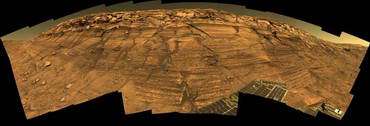Opportunity Driving Again

Opportunity has resumed driving after engineers determined an acceptable new way to stow the robotic arm during drives. With the arm in the newly approved stow configuration, the rover drove 2.4 meters (7.9 feet) on sol 707 (Jan. 19, 2006) to approach a rock called "Overgaard," chosen for close examination because of its cross-lamination texture.
When the European Space Agency's Mars Express orbiter was passing overhead, Opportunity used its panoramic camera and miniature thermal emission spectrometer for atmospheric observations coordinated with observations by the orbiter. The short Phobos and Deimos eclipse season started this week, and Opportunity observed transits of the moons.
Earlier, Opportunity completed a very long integration with the Moessbauer spectrometer and an overnight integration with the alpha particle X-ray spectrometer on a target called "Ted."
The panoramic camera finished high-resolution imaging of the area around the location where the rover worked for several weeks while engineers determined the new ways to use and stow the arm. Symptoms of a broken wire in a shoulder-joint motor had appeared back on sol 654 (Nov. 25, 2005).
While at that location, Opportunity also put its arm into various positions and photographed it with the front hazard-avoidance camera, a calibration activity that the team dubbed "Martian Tai Chi."
Sol-by-sol summaries
Sol 695 (Jan. 6, 2006): Continued Moessbauer spectrometer integration at Ted, sunset imaging, high-resolution imaging of an area with evidence of festooned crossbedding.
Sol 696: Overnight alpha particle X-ray spectrometer integration at Ted, imaging with the navigation camera for terrain and driving analysis.
Sol 697: Sky flat imaging with the microscopic imager, panoramic camera and navigation camera for image calibration. Normally the team would have stowed the robotic arm today (since arm work at this location is done), but since engineers have not yet determined the best stow position, we simply returned the arm to the ready position.
Sol 698: Observations with the miniature thermal emission spectrometer and navigation camera, calibration activity the team calls "Martian Tai Chi." During this activity, the arm is commanded to a few different positions and the front hazard-avoidance camera acquires images at each position. The arm location as reported by the spacecraft is compared to the location shown in the images so the arm model and camera model can be calibrated against each other.
Sol 699: Photometry observations with the navigation camera, start of acquiring a high-resolution blue stereo panorama of the surrounding outcrop (the "Fenway Panorama").
Sol 700: Miniature thermal emission spectrometer observations of the atmosphere and several outcrop targets, continued photometry observations.
Sol 701: Completion of Fenway Panorama and photometric observations.
Sol 702: Thirteen-filter observations of Overgaard with the panoramic camera, atmospheric remote sensing.
Sols 703 to 705: Intended stowing of the robotic arm on sol 704 was not successful due to faulting out of the shoulder-joint motor. The miniature thermal emission spectrometer made atmospheric observations coordinated with an overflight by Mars Express on sol 705. The panoramic camera was used for some super-resolution imaging.
Sol 706: Successful stowing of robotic arm, panoramic camera observations coordinated with Mars Express, observation of Deimos transit. The resistance for the shoulder azimuth joint was increased to 65 ohms (from 58 ohms) for this stow.
Sol 707: Opportunity drove back 1 meter (3.3 feet), took images, then drove forward 1.4 meters (4.6 feet) to a target called "Lower Overgaard."
As of sol 707 (Jan. 19, 2006) Opportunity's total odometry is 6,504.55 meters (4.04 miles).
Copyright 2006 by Space Daily, Distributed United Press International















